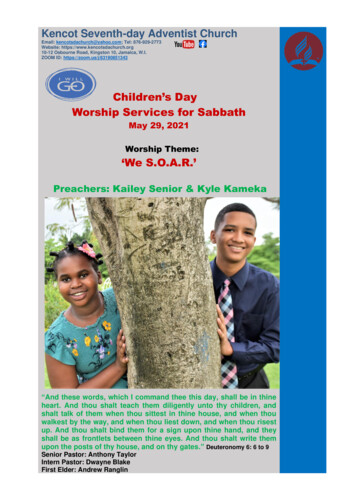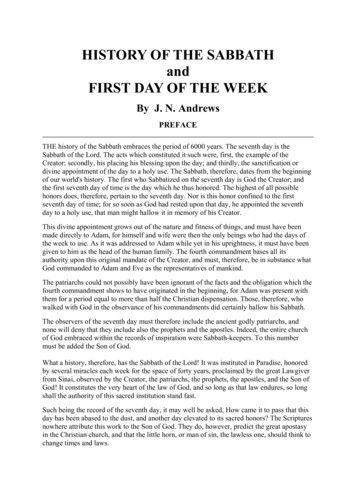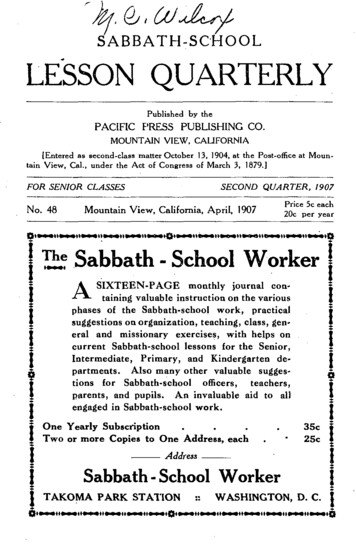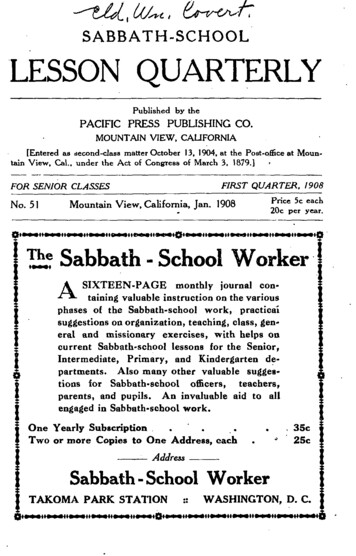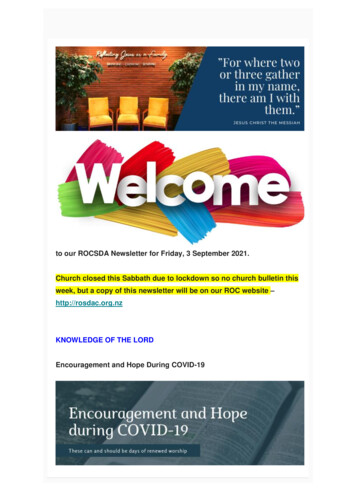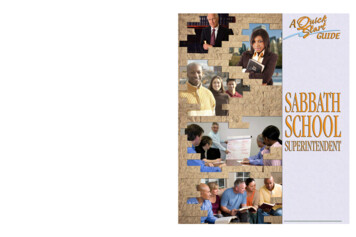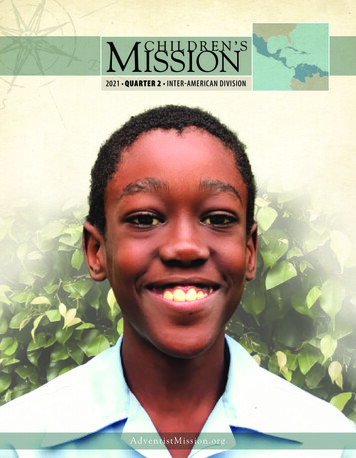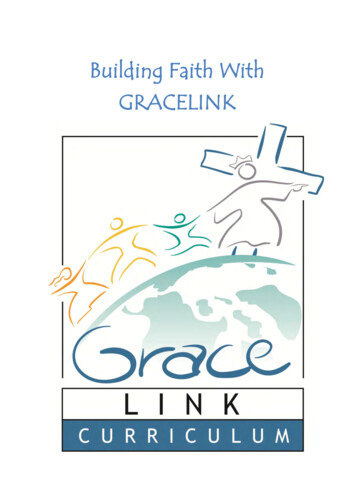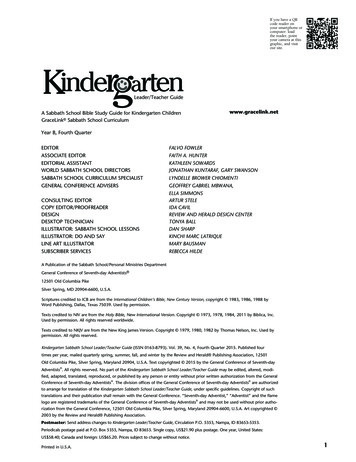
Transcription
If you have a QRcode reader onyour smartphone orcomputer: loadthe reader, pointyour camera at thisgraphic, and visitour site.Leader/Teacher GuideA Sabbath School Bible Study Guide for Kindergarten ChildrenGraceLink Sabbath School Curriculumwww.gracelink.netYear B, Fourth QuarterEDITORFalvo FowlerAssociate EditorFaith A. HunterEditorial AssistantWorld sabbath school directorsKathleen sowardsjonathan kuntaraf, gary swansonsabbath school curriculum specialistlyndelle brower chiomentiGeneral Conference advisersGEOFFREY GABRIEL MBWANA,ELLA SIMMONSConsulting EditorARTUR STELECOPY EDITOR/PROOFREADERIDA CAVILDesignReview and herald design centerDESKTOP TECHNICIANTONYA BALLillustrator: Sabbath school LessonsDan SharpIllustrator: Do and SayKinchi marc latriqueLine Art Illustratormary bausmanSUBSCRIBER SERVICESrebecca hildeA Publication of the Sabbath School/Personal Ministries DepartmentGeneral Conference of Seventh-day Adventists 12501 Old Columbia PikeSilver Spring, MD 20904-6600, U.S.A.Scriptures credited to ICB are from the International Children’s Bible, New Century Version, copyright 1983, 1986, 1988 byWord Publishing, Dallas, Texas 75039. Used by permission.Texts credited to NIV are from the Holy Bible, New International Version. Copyright 1973, 1978, 1984, 2011 by Biblica, Inc.Used by permission. All rights reserved worldwide.Texts credited to NKJV are from the New King James Version. Copyright 1979, 1980, 1982 by Thomas Nelson, Inc. Used bypermission. All rights reserved.Kindergarten Sabbath School Leader/Teacher Guide (ISSN 0163-8793). Vol. 39, No. 4, Fourth Quarter 2015. Published fourtimes per year, mailed quarterly spring, summer, fall, and winter by the Review and Herald Publishing Association, 12501Old Columbia Pike, Silver Spring, Maryland 20904, U.S.A. Text copyrighted 2015 by the General Conference of Seventh-day Adventists . All rights reserved. No part of the Kindergarten Sabbath School Leader/Teacher Guide may be edited, altered, modi-fied, adapted, translated, reproduced, or published by any person or entity without prior written authorization from the GeneralConference of Seventh-day Adventists . The division offices of the General Conference of Seventh-day Adventists are authorizedto arrange for translation of the Kindergarten Sabbath School Leader/Teacher Guide, under specific guidelines. Copyright of suchtranslations and their publication shall remain with the General Conference. “Seventh-day Adventist,” “Adventist” and the flamelogo are registered trademarks of the General Conference of Seventh-day Adventists and may not be used without prior authorization from the General Conference, 12501 Old Columbia Pike, Silver Spring, Maryland 20904-6600, U.S.A. Art copyrighted 2003 by the Review and Herald Publishing Association.Postmaster: Send address changes to Kindergarten Leader/Teacher Guide, Circulation P.O. 5353, Nampa, ID 83653-5353.Periodicals postage paid at P.O. Box 5353, Nampa, ID 83653. Single copy, US 21.90 plus postage. One year, United States:US 58.40; Canada and foreign: US 65.20. Prices subject to change without notice.Printed in U.S.A.1
A Letter to TeachersDear Teachers,Starting the first quarter of 2016, the GraceLink curriculum is receiving an update.Here’s what you can expect: The lesson will be reviewed in Sabbath School that the children have studied athome during the week. We’ve looked at study patterns and recognize that this methodcontinues to work well around the world. An opportunity will be provided for children to recite the memory verse that theyhave been encouraged to learn during the week. The Sharing the Lesson section of the lesson will be used for children to expresstheir experiences in telling others what they are learning about God’s love. A new section, Previewing the Next Lesson, will be used to build excitement for thefollowing week’s lesson. Lessons will be arranged in biblical chronological order. There will be a new design and layout for the student and teacher guide and newgraphics for the student guide that will also be repurposed for other Sabbath Schoolresources. There will be several new lessons that will provide a wider range of the biblicalnarrative.Change is sometimes difficult. Rest assured, the new graphics will still be child-friendlyand age-appropriate; there will still be a message for each lesson; there will still be creative activities, which will apply to all learning styles; and there will still be an active andinteractive approach to conducting Sabbath School. See! Change, with some things stillbeing the same. Please check the teachers guide very closely for further explanation of thenew features and effective instruction and management strategies.We pray that that the updates will provide support as our young ones continue togrow in Jesus and in His grace.Contact us through our website at www.gracelink.net.With Affection,The Editors2
The Kindergarten WritersAudrey Boyle Andersson—SwedenJackie Bishop—CaliforniaDeeAnn Bragaw—ColoradoLinda Porter Carlyle—OregonHelga Eiteneir—GermanyRené Alexenko Evans—TennesseeAdriana Itin Femopase—ArgentinaRené Garrigues-Goodwin—WashingtonFeryl Harris—West VirginiaDonna Meador—WashingtonVikki Montgomery—MarylandRebecca Gibbs O’Ffill—MarylandEvelyn Omaña—VenezuelaDenise Pereyra—CaliforniaDawn Reynolds—MarylandJanet Rieger—AustraliaJudi Rogers—MarylandDenise Ropka-Kasischke—CaliforniaEileen Dahl Vermeer—CanadaSpecial thanks to . . .Special thanks to Bailey Gillespie and Stuart Tyner of the John HancockCenter for Youth Ministry at La Sierra University for initial work in planning theGraceLink curriculum, and to Patricia A. Habada for coordinating the GraceLinkproject and seeing it to completion.ContentsCommunityWe treat each other with love.1 New Friends (October 3-9)* - - - - - - - - - - - - - - - - - - 102 Seven Special Helpers (October 10-16) - - - - - - - - - - 203 Two Men and a Strange Message (October 17-23) - - 304 In and Out of Prison (October 24-30) - - - - - - - - - - - 40Service We serve by giving to others.5 Helping Hands (October 31-November 6) - - - - - - - - 506 A Blind Man Learns to Lead (November 7-13) - - - - - 607 Come to My House (November 14-20) - - - - - - - - - - 708 Prison Praises (November 21-27) - - - - - - - - - - - - - - 809 Shipwrecked (November 28-December 4) - - - - - - - - 90Grace God’s grace is His gift to us.10 God’s Messengers (December 5-11) - - - - - - - - - - - 10011 The Best Gift (December 12-18) - - - - - - - - - - - - - - 11012 Dedicated to God (December 19-25) - - - - - - - - - - - 12013 He’s Coming Again (December 26-January 1) - - - - - 130*Lesson dates correspond with the GraceLink curriculum’s recommended method of presenting the lesson first in SabbathSchool and encouraging families to continue their study of the material during the week ahead. (See www.gracelink.net for athorough discussion.) If your church is not presenting the material first in Sabbath School, but rather reviewing it on Sabbathafter it has been introduced at home, you will need to adjust Our Little Friend distribution by one week.
Basic Needs of Children*All children have certain basic needs as well as needs that are specific to their age and stage ofdevelopment. The basic needs of children are:Physical Food Warmth ShelterMental Power—to make choices and follow plansEmotional A sense of belonging Expressions of unconditional love andacceptance Approval and recognition Freedom within defined boundaries Humor—a chance to laughSpiritual An all-knowing, loving, caring God F orgiveness of wrongs and a chanceto start over Assurance of acceptance with God E xperience in prayer, answers to prayer A chance to grow in grace and in theknowledge of GodThe Kindergarten ChildIn the Seventh-day Adventist Church we advocate kindergarten for children ages 3-5. However,the development of children varies from child to child. Therefore, a knowledge of each child in yourSabbath School is important. Generally, the description below is true of children ages 3-5.Physical Start developing large muscle coordination Lack a sure sense of balance Are extremely active Tire easily, but revive soon after resting Lack fine muscle coordination Are curious and like to explore theirenvironment Learn by exploringMental Are capable of limited listening and understanding without the help of a visual cue,such as seeing the object being discussed Have quick memory Memorize things they don’t understandEmotional Cry easily Are capable of verbalizing emotionalresponses Learn to delay gratification of needs without losing equilibrium Learn ways to express negative emotionsSocial/Relational Are self-centered—the world revolvesaround them4 Play alone in the presence of their friends,rather than playing with their friends Like to make friends and be with friendsDevelopmental NeedsIn addition to the basic needs mentionedearlier, kindergarten children need: Freedom—to choose and to explore withinlimits Power—to have some autonomy in learning situations Limits—safe boundaries that are set byparents and teachers Fun—learning through play, enjoying success Discipline and training—to provide safetyand structure in their livesSpiritual NeedsKindergarten children need to know: God loves them and cares for them How to show respect for God God made them, knows them, andvalues them The difference between right and wrong How to choose the right with God’s help
General RulesA child’s attention span, in minutes, is their age plus one. Thus, an average 3-year-old has a potential attention span of fourminutes, provided they are interested in what is happening.Kindergarten children: E njoy repetition—provided they don’t tire Are beginning to reason from simple cause to effect Make some generalizations—often incorrectly Learn best by active participation Have a short attention span—3 to 6 minutes*Children’s Ministries: Ideas and Techniques That Work, ed. Ann Calkins (Lincoln, Nebr.: AdventSource, 1997).About MaterialsAs you follow the natural learning sequence outlined in each lesson, you may want to adapt activities for use in yourparticular situation, and this may require a change in the need for materials. Look ahead at the Program Outline for eachweek’s program so you can be prepared with the materials suggested.Supplies Frequently Used in KindergartenPaperq butcher paper (roll)q c onstruction paper(various colors)q drawing paperq finger-painting paperq poster boardq writing paperArt suppliesqqqqqqqqqqqqq aluminum foilcotton balls or polyester fiberfillcraft stickscrayons, markers, colored pencilsfinger paints and watercolorsglue or glue stickshole punchmagnetic tape (stick-on)pencilsplastic wrapplay dough or modeling clayscissors (blunt-nosed)stamp pads (various colors)Otherq d olls (baby dolls)q fabric piecesq flashlightq gifts (inexpensive)qm agnets, smallq paper clips (steel)q paper towels/baby wipesq p lastic or newspaper to coverq adhesive bandagesq bags, paper and plastic, all sizesq balloonsq beanbagq blindfold for each childq blocks, boxes, or Legosq b oxes, large cardboard (applianceq r ecorded nature soundsq rubber bandsq s andwich bags, plastic sealableq s eeds (rice, beans, etc.)q shoe boxesq smocks/old shirts to coverq stapler and staplesq stringq tape (cellophane, masking, etc.)q thread, several colorsq t oilet paper or paper towel rollsqqqqqq(empty)yarn, several colorssize)audio playerc henille sticks or pipe cleanersc ostumes, Bible-times, for adultsand childrenc rown for each childc ups, paper and plastictableschildren’s clothesq stickers, large varietyq towels, smallq t oy musical instrumentsq toy stuffed animals5
Additional Supplies Needed This QuarterIn addition to those materials frequently used in kindergarten, specific items may be used only once during the quarter. Alist of such items is included here for your convenience. Keep in mind that this list DOES NOT include everything needed toteach a given lesson.Lesson 1q S haring Children patternqqqqqqq(see p. 150)t oy for each child to holdp ots, pans, bowls, spoons, etc. empty food boxesp lates, silverware, napkinsd uster, rags, broom, mopi tems children can sharef ood to shareLesson 2q l arge towelsq j igsaw pattern (see p. 151)q Helper Certificate (see p. 152)Lesson 3q i tems (or pictures) from differentqqqcountries and culturesb right lights heet hanging from ceilinga dult storyteller dressed as PeterLesson 7qqqqqqqqqqLesson 8qqqqqqqLesson 4q “ jail” (see activity)q praying pictures (see p. 153)q s hort lengths of chainLesson 5qqqqqqr oll of gauzep lay doctor’s kiti tems used by people who servef abric, needle, and threadg uest speaker (optional)l etter to parents (see activity)Lesson 6qqqqq6b room or stickt ransparent page protectorsv egetable oilB raille alphabet pattern (see p. 154)B raille Jesus pattern (see p. 154)v arious types of purple clothr ed and blue food coloringm ap of Paul’s journeyss uitcasei tems to take on a tripb ag (see activity)B ible-times felts (optional)g uest speakerW elcome Friends door hangerpattern (see p. 155)h eavy light-purple paperc haint wo adult male actorsr ockc ookiej ump ropei nformation about a missionary ormissionary guestM emory Verse Chain pattern(see p. 155)Lesson 9qqqqqqqqqqqqqqt hings good for sick peoplei tems not good for sick peoplep ot or large pans mall plastic boatsv inegarb aking sodas hakers (optional)b ox boats from Readiness ActivityA or sheet or masking tapeu mbrellass pray bottles for rainB oat pattern (see p. 156)w ood for firem ale voice of Paulw alnut shell halves (optional)Lesson 10q A ngel pattern (see p. 159)q l arge white T-shirts (optional)Lesson 11qqqqqqqqqi nexpensive gift for each childb aby lotionm usic boxs trawW ise Men’s giftst wo wrapped gift boxesi tems or pictures of God’s giftsp icture of Jesus, a baby, or theword “Jesus”A ngel Star pattern (see p. 160)Lesson 12q c repe paper, various colorsqm irrorq B ookmark pattern (see p. 161)Lesson 13q s uitcase or bagq i tems for packing suitcaseq S econd Coming picture(see p. 162)
Lesson Bible Story ReferencesMemory MessageVerseMaterialsCommunity: We treat each other with love.Lesson 1 The earlyOct. 3* Christians share.Acts 2:42-47; 4:32-35; Acts 4:32, NIVAA 70-76Lesson 2 Deacons care for Acts 6:1-7;Oct. 10 the needy.AA 87-96Romans 12:13,ICBGod’s children sharewhat they have.God’s people workSee p. 21.together to help others.Lesson 3 God sends Peter Acts 10;Acts 10:34, NIV Those who love GodOct. 17 a vision.AA 132-142will treat others withunderstanding andrespect.Lesson 4 Peter is put inOct. 24 prison.Acts 12:1-19;Acts 12:5, ICBAA 143-154See p. 11.See p. 31.In God’s Family wepray for one another.See p. 41.Service: We serve by giving to others.Lesson 5 DorcasOct. 31Acts 9:36-43; Proverbs 14:21,AA 131, 132ICBBeing kind to othersmakes us happy too.See p. 51.Lesson 6 Saul’s sight isNov. 7restored.Acts 9:1-22;Acts 9:17, NIVAA 112-125God leads us to serveothers.See p. 61.Lesson 7 Saul becomesActs 16:6-15;Acts 16:15, NIV We serve God when weNov. 14 Paul, meets Lydia. AA 211, 212, 218take care of others.See p. 71.Lesson 8 Paul and Silas inNov. 21 prisonActs 16:16-34;AA 211-2202 Corinthians8:21, NIVWe share Jesus by doing See p. 81.what is right.Lesson 9 Paul and theNov. 28 shipwreckActs 27:13-28:10;AA 442-4461 Thessalonians5:11, NIVWe serve others whenwe encourage them.See p. 91.Lesson 10 An angel visits Matthew 1:18-25; Hebrews 1:14,Dec. 5 Mary.Luke 1:26-38; 2:8-14;ICBDA 43-48God sends angels tohelp us.See p. 101.Lesson 11 Wise Men andLuke 2:15-20;Luke 2:11, NIVDec. 12 shepherds visit Matthew 2:1, 10, 11;Baby Jesus.DA 48, 59-67Jesus is the best giftfrom God.See p. 111.God shares His giftwith everyone.See p. 121.Grace: God’s grace is His gift to us.Lesson 12 Baby Jesus isLuke 2:21-38; Psalm 127:3,Dec. 19 dedicated to God. DA 50-58ICBLesson 13 Second Coming Matthew 24:27, 30, 31, Revelation 1:7,Jesus is coming soon!See p. 131.Dec. 2642; John 14:1-3; NIV1 Thess. 4:16, 17;Rev. 1:7; GC 640-645*Lesson dates correspond with the GraceLink curriculum’s recommended method of presenting the lesson first in Sabbath Schooland encouraging families to continue their study of the material during the week ahead. (See www.gracelink.net for a thorough discussion.) If your church is not presenting the material first in Sabbath School, but rather reviewing it on Sabbath after it has been introduced at home, you will need to adjust Our Little Friend distribution by one week.7
To the Leaders/TeachersThese guides were developed to:A. Introduce the lesson on Sabbath. The child then reviews and appliesthe principles studied with the help of their parents and Bible study guidesduring the week. In this way, the lessons learned in Sabbath School becomea vital part of the child’s growing faith experience. Memory verses, whichare also learned in Sabbath School, are reviewed and reinforced during thefollowing week, connected in the child’s mind with the interesting learningactivities they have already experienced.B. Focus the entire Sabbath School time on one message. These messages each relate to one of the four dynamics of a growing faith experience:grace (God loves me), worship (I love God), community (we love eachother), and service (God loves you, too).41TheSharing theReadinessLesson gives the chil-Activities give thedren a chance to developchildren a reason to wantways that they can share theirnew concept with others. Thisto learn the lesson. This sec-section appeals to dynamic learn-tion appeals to imaginativeers, who ask, “What can this become?What can I do to share this idea withlearners, who ask, “Why should Ilearn this?”Theothers?”Prayer and Praise sectionis the time-honored “business” of SabbathApplying theSchool and may be used at any point duringLesson gives the children a chanceto explore how the lesson can beapplied in a practical way intheir daily lives. This sectionappeals to commonsense3learners, who ask,“How does it workin my life?”Thethe lesson; however, it is recommendedthat you begin with ReadinessBibleActivities, even whilesome children areLesson lets youteach the children the content in a way that involves them.This section appeals to theanalytical learners, who ask,“What do I need to learn?”28still arriving.
C. Reach each child in the way they learn best. By following the naturallearning sequence on which these outlines were based, you will also connectstudents with “the message” for the week in a way that will capture eachone’s attention and imagination.D. Give students active learning experiences so they can more readilyinternalize the truths being presented. These experiences are followed bydebriefing sessions in which you ask questions that lead the children toreflect on what they experienced, interpret the experience, and apply thatinformation to their lives.E. Involve the adult Sabbath School staff in new and flexible ways. A very small Sabbath School can be managed by one adult. A larger Sabbath School can be managed by one leader/teacher withother adult volunteers to facilitate the small group interaction. This givessmall group facilitators a maximum involvement with the students andtheir dynamic learning, while requiring a minimum of preparation on thefacilitator’s part. A creative alternative is to enlist leaders/teachers with different personallearning styles to lead different segments of the program.(For more detailed information about the natural learning cycle, the learningstyles, and other dynamics of teaching and learning, contact your Adventist BookCenter or your Sabbath School or children’s ministries director.)To use this guide . . .Try to follow the natural learning cycle outlined, but adapt it as necessary tomake the program work in your particular situation.Look ahead at the Program Outline for each week’s program so you can beprepared with the simple materials suggested.9
l e s sonYear B4th QuarterLesson 1New FriendsCommunity We treat each other with love.ReferencesActs 2:42-47; 4:32-35; The Acts of the Apostles, pp. 70-76.Memory Verse“They shared everything they had” (Acts 4:32, NIV).ObjectivesThe children will:Know that God asks us to share what we have with others who need help.Feel a desire and excitement to share with others.Respond by willingly sharing with others in need.The Message od’s children share what they have.GGetting Ready to TeachThe Bible Lesson at a Glance This is a lesson about community.The apostles are spreading the goodnews about Jesus in Jerusalem. Manynew believers have come from far awayand have stayed to learn more aboutJesus. Many of them are running outof food and money. The Christians inJerusalem share what they have withthe new believers. No one has needs,because everyone is taken care of. Onefamily shares their food with new believers who have come a long way to learnabout Jesus.10Sharing is a concept to which allchildren can relate. They share withtheir siblings, their parents, neighborhood children, and others. In aChristian community people happilyshare what they have with others.Teacher Enrichment“This liberality on the part of the believers was the result of the outpouring ofthe Spirit. The converts to the gospel were‘of one heart and of one soul.’ One com-
oneProgram Outline1*2Lesson SectionMinutesActivitiesWelcomeongoing Greet students at door; hearpleased/troubled4noneReadinessup to 10A. Sharing CrayonsOptionsSharing Children pattern (see p. 140),paper, crayons B. Sharing Giftsstickers or other inexpensive giftsC. Musical Toys toys, audio player and recordedmusic or pianoPrayer andPraise*up to 10Bible Lessonup to 20See page 16.*Prayer and Praise may beused at any time during the program.3Materials NeededExperiencing the Story pots, pans, bowls, spoons, bakingdishes; empty food boxes; plates,silverware, napkins; duster; rags;broom; mopBible StudyBibleMemory VerseBibleApplyingup to 15Easy and Hardthe Lessonvarious items (see activity), bag,Little Voices Praise Him songbookSharingthe Lessonfood to share, sealable plastic bagsup to 15mon interest controlled them—the successof the mission entrusted to them; andcovetousness had no place in their lives.Their love for their brethren and the causethey had espoused, was greater than theirlove of money and possessions” (The Actsof the Apostles, pp. 70, 71).“None should be content to feed onthe bread of life without sharing it withthose around them” (Testimonies for theChurch, vol. 5, p. 606).“In a special sense, Christ has laidupon His church the duty of caring forthe needy among its own members”(The Ministry of Healing, p. 201).Food ShareAre you willing to share everything?Room DecorationsCreate the atmosphere of Palestineduring the first century A.D.—dry, barren,and dusty. Use rocks, sand, or dirt to addto the landscape. Recreate a simple homeby using either cardboard boxes or a woodframe, painted stone color. Set up thehouse either as a house front or as an openfront with two side walls and a back wall.Include a bedroll in the corner, a cardboardbox stove (with a circle cut out and withsticks inside, or with just a circle drawn ontop), a simple bench or chair, and a table.11
Lesson 1Teaching the LessonWelcomeWelcome students at the door. Ask how their week has been—whatthey are pleased/troubled about. Encourage them to share any experiences from last week’s lesson study. Have them begin the readinessactivity of your choice.1Readiness ActivitiesSelect the activity most appropriate for your situation.A. Sharing CrayonsYou Need:q SharingChildrenpattern(see p. 140)q paperq crayonsIn advance, prepare a copy of the Sharing Children pattern(see page 140) for each child, and have several crayons ofeach color. Seat the children at different tables in groups.Give each group crayons of only one color. Ask the childrento follow your directions exactly: color the picture, using different colors (color the shirt blue, the grass green, the shoesbrown, etc.), and they may start with any color. The only wayfor the children to complete the picture as you instructed is toshare colors. If you have a small group of children, give eachchild one color.DebriefingAllow responses as you ask: What do you think about having only onecolor of crayon at your table? Were there enough crayons for everyone? How did you like sharing? How did you feel when someoneshared with you? God loves it when we happily share with others.Our Bible story is about people who shared everything they had withothers. They shared because they loved Jesus. Today’s message is:God’s children share what they have.Say that with me.B. Sharing GiftsYou Need:q stickersor otherinexpensivegiftsGive two items each to only half of the children. Ask themwhat they are going to do with both items. Some of the children will probably share; others may not. Allow time; thengive gifts to the children with whom nothing was shared.DebriefingAllow responses as you ask: What do you think aboutgetting two things when others did not get any? How did it feel notto get anything? What did you think when someone shared with12
Lesson 1you? How did it feel to share with someone who did not get something? Is it important to share? Why? God loves it when we happilyshare with others. Our Bible story is about people who shared everything they owned with others. They were happy that they shared.Today’s message is:God’s children share what they have.Say that with me.C. Musical ToysGive a toy to each child. Say: We’re going to play asharing game. Let’s all sit in a circle and hold a toy.When the music is playing, pass the toy to the personnext to you. Do it carefully. Keep passing the toysuntil the music stops. When the music stops, holdon to the toy you have, and say to the person whopassed it to you, “Thank you for sharing.”You Need:q toy for eachchild toholdq audioplayer andrecordedmusic orpianoDebriefingAllow responses as you ask: How did you feel whenyou were being given toys? (It was fun; happy.) Didyou want to keep any toy? (varied answers) We areGod’s children and God’s children share with others. God loves itwhen we happily share with others. Our Bible story is about peoplewho shared all they owned with others. They were happy that theyshared, because they loved Jesus. Today’s message is:God’s children share what they have.Say that with me.*NOTE: Prayer and Praise appears on page 16.13
Lesson 12Bible LessonExperiencing the StoryAs you tell the story, be preparedto stop for an activity in which thechildren will pretend to prepare a pots, pans,meal and clean house. Have thebowls,items in place. (Try to have an itemspoons,for each child or help the childrenbakingimagine that they have them.) Formdishes, etc. empty food two groups. Have one group sit nearthe cleaning supplies. Have the otherboxessit near the cooking utensils. plates,To begin, say: Let’s pretendsilverware,thatwe lived during Biblenapkinstimes.We have heard the dusterapostlespreach and know ragsthattheyare telling many broompeopleaboutJesus. And we mopcan help them in a specialway. Let’s listen to find out whatwe can do.You Need:qqqqqqqRead or tell the story.“Do a good job now, little Deborah,”Mama said with a smile. “We’re going tohave company for supper again tonight.”Deborah looked up. “Who is coming?” she asked.“I don’t know yet,” Mama answeredwith a twinkle in her eye.Mama pulled little Deborah onto herlap and kissed her rosy cheek. “I will explain it to you,” Mama said.“You know that the apostles are preaching the good news about Jesus all over ourcity. Hundreds of people are learning aboutJesus every day,” Mama began.Deborah nodded.“Well,” Mama went on, “many of thenew believers are from far away. Theycame to Jerusalem for the great feast.They heard the apostles and learnedabout Jesus, and now they want to stayhere for a while and learn even moreabout Him. Some new believers from far14away have no more money. So we arehelping them. We will share God’s lovewith them by sharing our supper.”Deborah slid off Mama’s lap. “I’d better hurry and finish sweeping,” she said.Mama mixed a batch of bread. Shekneaded and pounded the dough andshaped it into loaves. She put the loavesin the oven. The wonderful smell of baking bread soon filled the house.[Stop here and ask, “How can wehelp?” Have the children pretend toclean house and make bread. Allow a fewminutes; then have the children sit down.Continue the story.]There was a knock at the door.Mama’s friend scurried in. “I have extralentils,” she announced as she put aheavy sack on the table. “I thought youmight be able to use them,” she smiled.“That’s a lot of lentils, Mama,” littleDeborah said.“You’re right,” Mama agreed. Shepicked up the big sack and weighed it inher hands. “God is providing extra food.This will make lots of soup. God mustbe bringing lots of people to supper tonight,” she said.[Stop here and allow time for the cooking group to “make soup” while the othergroup cleans some more; then continue.]“How is my beautiful family?” Papa’sbooming voice filled the house. Hescooped little Deborah up and gave hera gigantic hug. He put an arm aroundMama and hugged her, too. “That soupsure smells good!” Papa exclaimed, peering into the big pot. “You make the bestsoup in all of Jerusalem!”“We’re sharing our supper!”
Lesson 1Deborah exclaimed. She twirled acrossthe floor. “We’re sharing God’s lovewith the new believers.”“I know,” Papa said. He squatteddown and held little Deborah’s face between his hands. “I will get cleaned up,and then you and Mama and I will go tothe place where the apostles are teaching. We will find hungry believers andbring them home and feed them. I’mglad to see you have everything ready.”“And while we eat we will talkabout Jesus,” Deborah said. “That’smy favorite part!”DebriefingAllow responses as you ask: What doyou think that people who sharedduring the time of the apo
Kindergarten sabbath school leader/teacher guide (ISSn 0163-8793). vol. 39, no. 4, Fourth Quarter 2015. published four times per year, mailed quarterly spring, summer, fall, and winter by the Review and herald publishing Association, 12501

